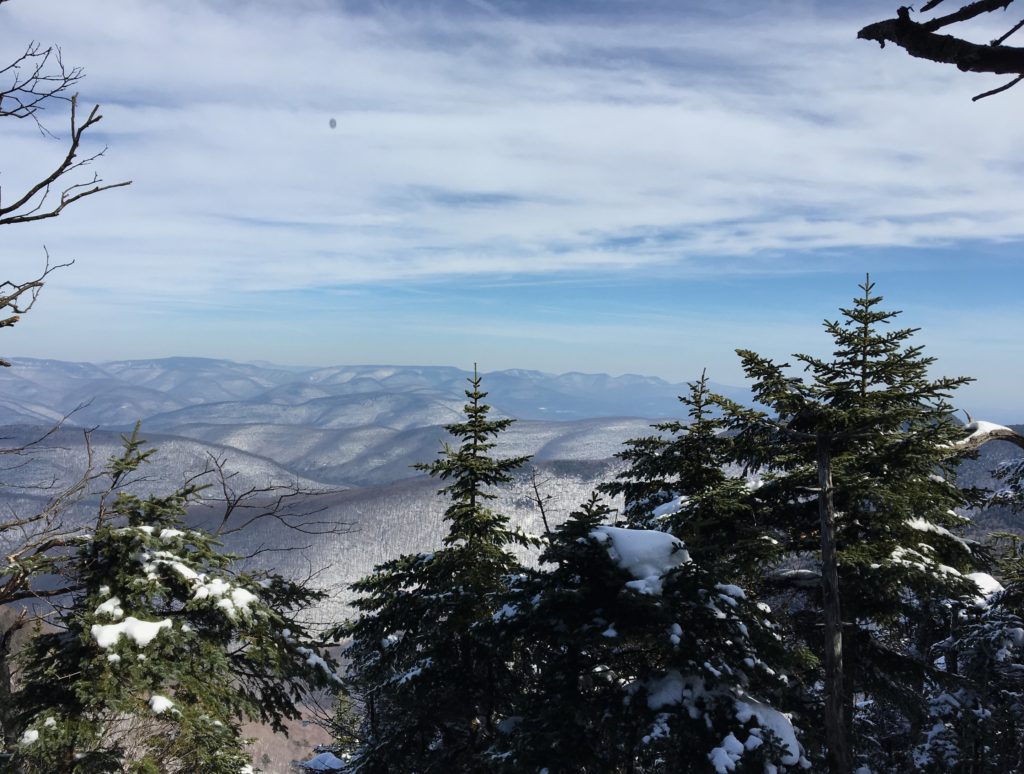
Winter hiking in the Catskills can get dangerous very quickly. One minute you could be trotting along atop a magical winter wonderland, but take your gloves off for a few minutes to take a picture and end up with frostbite.
Water can freeze in your backpack by the time you’ve reached the summit of a mountain when you’re most dehydrated. If you’re layered with cotton and start sweating on your ascent, you’ll stay wet and soggy for the duration of the hike, which makes you more vulnerable to plunging temperatures. Your food can freeze and be impossible to bite or cut up. And then, of course, you can get lost or step into a deep snow pile and twist an ankle, which is easy to do on very rocky summits like Balsam and Giant Ledge.
Perhaps we should call this the Pessimists Guide to Winter Hiking. As we’re all keenly aware however, life in general is sort of dangerous these days wherever you go, and the outdoors is the safest option to enjoy the company of friends and extended family. Plus, there’s nothing more satisfying than eating your lunch while absorbing the views from some the Catskills’ highest ledges and summits.
Top tips: Don’t hike with a hangover. Start drinking water the night before and drink few pints of water before you set out, so you don’t have to carry extra, because water makes your backpack much heavier. Take an empty vessel so you can melt some snow in an emergency. Eat a hearty breakfast. Include highly calorific, but light foods in your backpack like grilled bacon, sliced meat, nuts, chocolate or boiled eggs. Take a hot beverage in a light flask to drink at the summit. Always take a lighter, some pocket hand warmers and a sturdy knife to break ice. Have a full battery on your phone. Most important: take the number of the local forest ranger before you start hiking and tell family or friends where you’re going.
And we haven’t even got to the equipment yet, but you definitely need spikes or crampons for winter hiking. Another (literally) handy tip: for summits with overhangs, like Kaaterskill High Peak or the Blackhead Range, some gardening gloves with rubber palms become handy for when you’re pulling yourself up over cold boulders.
Can someone please make hand crampons? Gloves with spikes on them?
Here’s the full range of tips for winter hiking preparedness:
Equipment
Always take a headlamp in case you get stuck outside after dark. Many of the summits of the mountains have no signage and it’s easy to overshoot summits like Panther and Westkill where the trail continues much further on to a different parking lot where it’s likely you did not park. Hiking poles, that are like ski-poles, help you keep your balance. And the aforementioned crampons while keep you upright on icy surfaces. Crampons are basically spikes embedded into thick rubber that fit over your shoes. They are essential gadgets for winter hiking, so if you’re facing an expensive choice between poles and crampons, choose the crampons. Also, sunscreen: you can still catch the sun in winter at high altitudes and of course, a first aid kit and a whistle.
Clothing
Never wear cotton. At least never wear cotton against your skin. Cotton is heavy and rough when wet and will act like a soggy towel against your body. Always wear moisture wicking clothing that take sweat away from your body like fleece, polyester or wool. Wear many layers. Ideally: first layer: polyester. Second layer: fleece. Third layer: Wool. Fourth layer: insulated, waterproof jacket.
Invest in a good pair of hiking socks because you need to give your feet more love than anything else. Also, a waterproof pair of hiking boots because the Catskills has many springs, tributaries, streams and rivers to cross on the trails.
You don’t want to overload your pack, but it’s smart to take spares of things like socks, hats and gloves because they tend to get wet first.
Maps
The best maps are from the NYNJ Trail Conference, which you can buy here. Don’t leave home without the relevant map of your hike, and a compass. If you’re a novice hiker you can choose hikes that don’t cross water by looking at these maps ahead of time.
Books on the Catskills – both hiking and history are plentiful. Find some at The Catskill Center website. There are a handful of plane wrecks, abandoned buildings, old ski centers, and other historic landmarks in these mountains to investigate. There are also five fire towers to explore, but the Catskills also has a rich geological history, having once been at the bottom of the sea in the Bahamas. Read A History of the Catskills Forest by Michael Kudish to literally explore the ground beneath your feet.
Consider forming or joining a hiking club like the Catskill Mountain Club or the Catskill 3500 Club.







Pingback: Five Spectacular Catskills Winter Day Hikes | UPSTATE DISPATCH